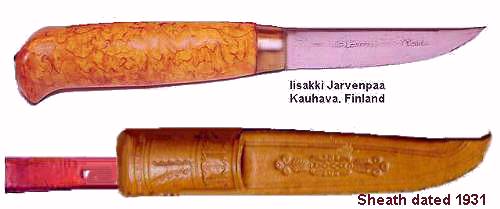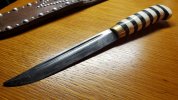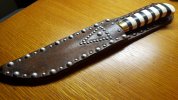-
The BladeForums.com 2024 Traditional Knife is available! Price is $250 ea (shipped within CONUS).
Order here: https://www.bladeforums.com/help/2024-traditional/
You are using an out of date browser. It may not display this or other websites correctly.
You should upgrade or use an alternative browser.
You should upgrade or use an alternative browser.
The Puukko
- Thread starter t.sous11
- Start date
- Joined
- Sep 15, 1999
- Messages
- 2,112
- Joined
- Dec 1, 2016
- Messages
- 11,069
THIS JUST OFF THE BENCH - A Yrjö Puronvarsi/ YP Taonta Sheepsfoot blade.
I started with this ~
View attachment 1365327
And after quite a struggle (this was my very first handle project) and some start overs I ended up with this ~
View attachment 1365326
All in the stack - Teak - Antler - Birch Bark - Teak - Antler
View attachment 1365328
View attachment 1365329
I am not sure how I missed this, Ray. That looks fantastic, nicely done!
screened porch
Basic Member
- Joined
- Feb 19, 2012
- Messages
- 19,299
This is unmarked, but it looks like a puukko to me.


screened porch
Basic Member
- Joined
- Feb 19, 2012
- Messages
- 19,299
Good eye. That does look close.This is unmarked, but it looks like a puukko to me.

- Joined
- Oct 17, 2015
- Messages
- 11,464
the
Dark stripes look like wood. The white looks synthetic but not sure. Cool well built knife.Is that a wood and ivory handle or all synthetic? Looks as if it has grain structure and so I ask.
It's growing on me Mike
RayseM
Platinum Member
- Joined
- Feb 18, 2010
- Messages
- 8,269
the
Dark stripes look like wood. The white looks synthetic but not sure. Cool well built knife.
Might be worth a test on the white to see if it is bone, ivory or artificial.
A few ways to test - (Copied from a few web sources.)
1) Hot needle test. Heat a needle red-hot and touch it lightly to the ivory. If it is real, it will burn and stink something terrible! When touched with a hot needle, genuine ivory chars and turns black; a hot needle will cause artificial material to melt or burn.
HOWEVER: first, it's destructive to the piece tested, second, it doesn't tell you the type of ivory you're looking at. Knowing the kind of ivory you're dealing with is now extremely important due to the laws banning the sales of whale ivories.
2) Black Light Using black light is an important first step because it saves time by ruling out artificial materials. Virtually all plastics and resins fluoresce blue or blue/white under long wave black light regardless of the surface color in ordinary light. Genuine ivory usually fluoresces white but this can vary depending on whether the ivory has a patina. Most natural old patinas fluoresce dull yellow or brown. Be very suspicious of any brightly colored fluorescence such as yellow as this indicates artificial aging in dung, urine or animal fats. Use black light as your first test, not your only test. Black light is useful for eliminating artificial materials but can not alone prove a piece is ivory. Bone, vegetable ivory (cellulose) and glued together ivory dust, for example, all react like genuine ivory under black light.
3) There might be more. Maybe just a close study under a magnifier will reveal some structure.
Ivory is formed by living growing tissue. The direction and forms of growth are unique to each ivory producing species. These unique grain structures have so far been impossible to duplicate in artificial substances like plastics and resins. Generally, grain always runs along the long dimension of a piece of authentic worked ivory.
Attempts to put grain in artificial ivory go back over 100 years. Celluloid, one of the earliest plastics invented in 1868, has a prominent grain. Grain in celluloid and other artificial ivory is usually easy to detect because it normally appears as nearly perfectly parallel lines and shows a definite repeating pattern. Grain in natural ivory is random without any noticeable pattern. A repeating pattern with uniform even lines is almost always a sign of a man-made artificial ivory.
The presence of grain also allows us to eliminate other natural non-ivory materials such as bone and glued together ivory dust. But like the black light test, grain alone does not guarantee a piece is ivory. You must use several tests before you can make an accurate judgement.
Worth some study, I think. Would help to age the knife too.
Campbellclanman
Platinum Member
- Joined
- Mar 10, 2007
- Messages
- 15,820
Very nice Vintage - actually with the age of these now slots into the Antique frame. I was told that these came out in the 1920's and that the style of Knife has never really changed- and why would you? Fantastic Knives - I very much like this example, its old The Birch Bark Handle is simply gorgeous - Just a great old Knife!








Campbellclanman
Platinum Member
- Joined
- Mar 10, 2007
- Messages
- 15,820
Here are a couple of very nice larger examples of the Puukko.
This example is 1/8th off 11 inches long, and in totally unused condition. An absolute pleasure to hold i the Hand, screamingly Sharp!
No Sheath with this one, I could stare at this Knife all day!


Cant quite make out the Makers Name here...

Another large 11 inch Puukko, Slightly different Grind with no Guard and rounded Bolster Treatment, this Knife has barely been used at all - and such a joy to hold!
I'm told the Pukkoo's were made and the Sheaths were made or bought separately?Nice Sheath that accompanies a gorgeous Puukko, made by the esteemed K. Lammi, Inside the Fuller Reads: K. Lammi Kauhava.



This example is 1/8th off 11 inches long, and in totally unused condition. An absolute pleasure to hold i the Hand, screamingly Sharp!
No Sheath with this one, I could stare at this Knife all day!


Cant quite make out the Makers Name here...

Another large 11 inch Puukko, Slightly different Grind with no Guard and rounded Bolster Treatment, this Knife has barely been used at all - and such a joy to hold!
I'm told the Pukkoo's were made and the Sheaths were made or bought separately?Nice Sheath that accompanies a gorgeous Puukko, made by the esteemed K. Lammi, Inside the Fuller Reads: K. Lammi Kauhava.



Campbellclanman
Platinum Member
- Joined
- Mar 10, 2007
- Messages
- 15,820
This was bought off a local Maker of these stunning Knives a few years ago when he appeared here in the earlier stages, my Friend Roland whom gifted me this Stunning Knife! Roland told me he bought it to support a new maker of Knives as support- which I thought was just neat!
I'm glad Roland did, because this maker is Malanika ( Danijel Haramina) and he makes outstanding Puukko's! in fact when he lists one its gone pretty much straight away! The Blade has his the mark on it - I hope I am 100% correct with this information, I am certainly glad to have this fantastic example of a slightly used and still extremely sharp Knife- Love the Plain Traditional Puukko that this is, but even just looking at the Handle - the perfect symmetry and lovely Grain!
The Sheath is so nicely done, the retention of the Knife is magnificent- Locked in with the Wooden inner works produced by the hands of a true Traditional Tradesman - the Locks "snaps" into place when pushed home giving the owner security that the Knife stays in place, a real nice little handful to say the least!





Last but certainly not least, another lovely Traditional Puukko, smaller this time at 7 & 3/4 inches long, being a non informed bloke about the Puukko world, I do not instantly recognise the Names inside the Fullers- I am sure in time I would do- Puukkos have always interested me, but would love to hear of your opinion on Makers of this and the other Larger Puukko above....( many thanks in advance for this )....
I always thought the Traditional Sheaths were so very cool,when one thinks of Cardboard sheaths - it is astounding to see just what these Sheaths can go through and last- again local knowledge from the Traditionalist is always intriguing.
The Sheath is in superb shape- as is the Knife - both having very little use.
Again, I love these Handles, this one with most probably the last owners Name so neatly carved in Isacc Keski





I'm glad Roland did, because this maker is Malanika ( Danijel Haramina) and he makes outstanding Puukko's! in fact when he lists one its gone pretty much straight away! The Blade has his the mark on it - I hope I am 100% correct with this information, I am certainly glad to have this fantastic example of a slightly used and still extremely sharp Knife- Love the Plain Traditional Puukko that this is, but even just looking at the Handle - the perfect symmetry and lovely Grain!
The Sheath is so nicely done, the retention of the Knife is magnificent- Locked in with the Wooden inner works produced by the hands of a true Traditional Tradesman - the Locks "snaps" into place when pushed home giving the owner security that the Knife stays in place, a real nice little handful to say the least!





Last but certainly not least, another lovely Traditional Puukko, smaller this time at 7 & 3/4 inches long, being a non informed bloke about the Puukko world, I do not instantly recognise the Names inside the Fullers- I am sure in time I would do- Puukkos have always interested me, but would love to hear of your opinion on Makers of this and the other Larger Puukko above....( many thanks in advance for this )....
I always thought the Traditional Sheaths were so very cool,when one thinks of Cardboard sheaths - it is astounding to see just what these Sheaths can go through and last- again local knowledge from the Traditionalist is always intriguing.
The Sheath is in superb shape- as is the Knife - both having very little use.
Again, I love these Handles, this one with most probably the last owners Name so neatly carved in Isacc Keski





Campbellclanman
Platinum Member
- Joined
- Mar 10, 2007
- Messages
- 15,820
Howdy Arathol
Once again kind Sir you are a great help, the name is the same on both of the Knives, so you have answered my question nicely.
Many Thanks for this!
Once again kind Sir you are a great help, the name is the same on both of the Knives, so you have answered my question nicely.
Many Thanks for this!
Bigfattyt
Gold Member
- Joined
- Jun 23, 2007
- Messages
- 19,240
I just finished this one this week.
My 4th attempt at a knife. First hidden tang.
Learned a few things. 15n20 blade, heat treated in a gas forge. Oil quench.
Burned hickory handle. The end plates are also 15n20. I also made 4 small nails out of the blade steel, peeened the tops, and used them to secure the end cap and "guard". Epoxy and peened the tang through the end cap.
First wood core sheath.




.07 thick. Really cuts well! My first knife our of that steel at that thickness too.


My 4th attempt at a knife. First hidden tang.
Learned a few things. 15n20 blade, heat treated in a gas forge. Oil quench.
Burned hickory handle. The end plates are also 15n20. I also made 4 small nails out of the blade steel, peeened the tops, and used them to secure the end cap and "guard". Epoxy and peened the tang through the end cap.
First wood core sheath.




.07 thick. Really cuts well! My first knife our of that steel at that thickness too.


Not sure what you mean by the same name is on both of the knives? Iisakki Järvenpää is the maker of the smaller knife, and Kauhava is the name of the town in Finland where it was made. Järvenpää died in 1929, and his family has used the name and run the shop ever since.Howdy Arathol
Once again kind Sir you are a great help, the name is the same on both of the Knives, so you have answered my question nicely.
Many Thanks for this!

The first knife was not made by Iisakki Järvenpää and is of recent production.








